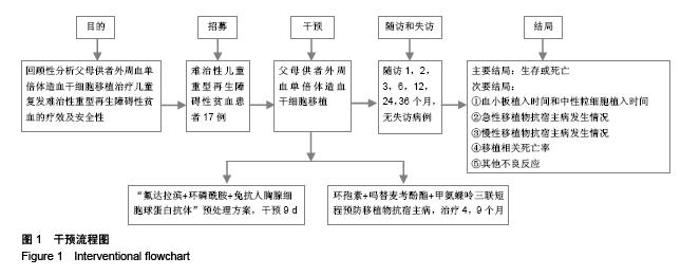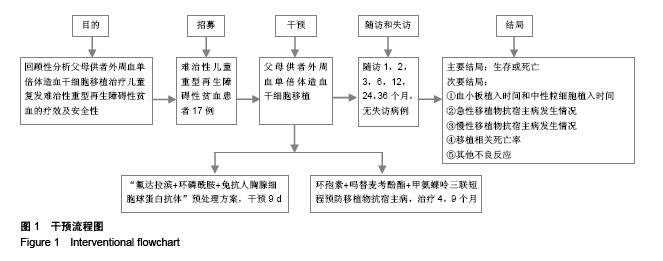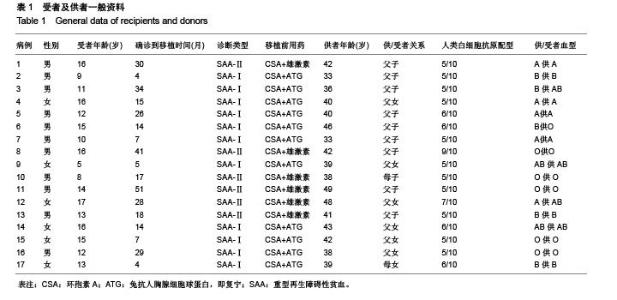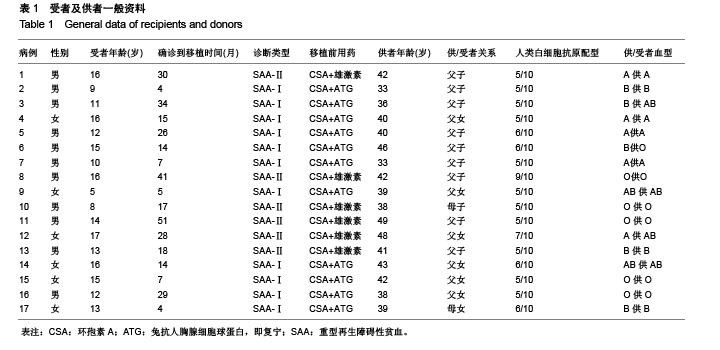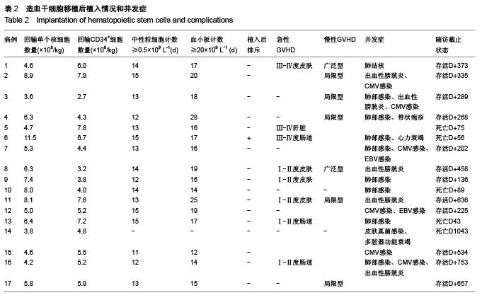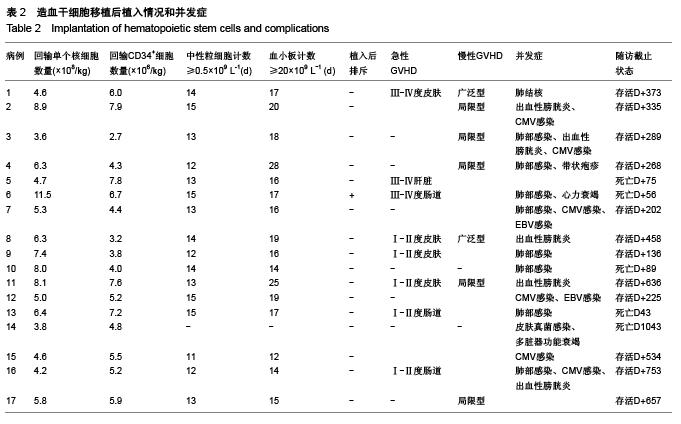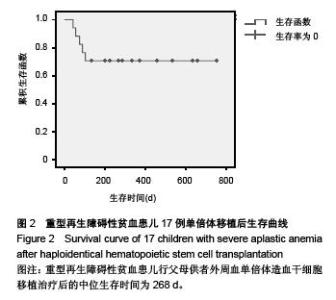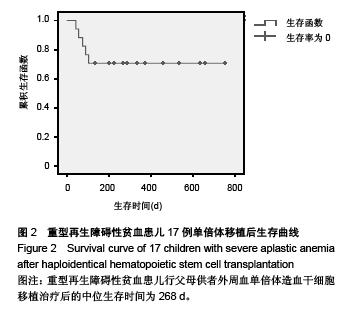Chinese Journal of Tissue Engineering Research ›› 2015, Vol. 19 ›› Issue (50): 8095-8101.doi: 10.3969/j.issn.2095-4344.2015.50.011
Previous Articles Next Articles
Parental haploidentical peripheral blood stem cell transplantation for treatment of children with refractory severe aplastic anemia
- Department of Hematology, the First Affiliated Hospital of Zhengzhou University, Zhengzhou 450052, Henan Province, China
-
Received:2015-10-25Online:2015-12-03Published:2015-12-03 -
Contact:Wan Ding-ming, Department of Hematology, the First Affiliated Hospital of Zhengzhou University, Zhengzhou 450052, Henan Province, China -
About author:Wan Ding-ming, M.D., Professor, Chief physician, Master’s supervisor, Department of Hematology, the First Affiliated Hospital of Zhengzhou University, Zhengzhou 450052, Henan Province, China Chen Xiao-na, Studying for master’s degree, Department of Hematology, the First Affiliated Hospital of Zhengzhou University, Zhengzhou 450052, Henan Province, China -
Supported by:the Funding for Phase III 211 Engineering, No. 142-52000570
CLC Number:
Cite this article
Wan Ding-ming, Chen Xiao-na, Cao Wei-jie, Xing Hai-zhou, He Hai-yan, Liu Fei, Chen Shi-yu, . Parental haploidentical peripheral blood stem cell transplantation for treatment of children with refractory severe aplastic anemia [J]. Chinese Journal of Tissue Engineering Research, 2015, 19(50): 8095-8101.
share this article
| [1] Marsh JC, Killick SB, Bown N, et al. Guidelines for the diagnosis and management of aplastic anaemia. Br J Haematol. 2015. [2] Biswajit H,Pratim PP, Kumar ST, et al. Aplastic anemia: a common hemotological abnormality among peripheral pancytopenia. N Am J Med Sci. 2012;9(4):384-388. [3] 中华医学会儿科学分会血液学组.《中华儿科杂志》编辑委员会.儿童获得性再生障碍性贫血诊疗建议[J].中华儿科杂志,2014, 52(2)103-106. [4] 万鼎铭,何海燕,边志磊,等.父母供者外周血单倍体干细胞移植治疗儿童复发难治性白血病[J].中国组织工程研究,2014, 18(32): 5237-5243. [5] Peinemann F, Barrel C, Grouven U. First-line allogeneic hematopoietic stem cell transplantation of HLA-matched sibling donors compared with firstline ciclosporin and/or antithymocyte or antilymphocyte globulin for acquired severe aplastic anemia. Coehrane Datahase Syst Rev. 2013;23(7): CD006407. [6] 陈欣,魏嘉璘,黄勇,等.HLA匹配同胞供者异基因造血干细胞移植治疗重型再生障碍性贫血41例疗效分析[J].中华血液学杂志, 2012,33(8)610-614. [7] Lazarus HM, Advani AS.When, how, and what cell source for hematopoietic cell transplantation in first complete remission adult acute lymphoblastic leukemia. Hematollogy Am Soc Hematol Educ Program. 2012:382-388. [8] George B, Mathews V, Lakshmi KM, et al. The use of a fludarabine-based conditioning regimen in patients with severe aplastic anemia: a retrospective analysis from three Indian centers. Clin Transplant. 2013;27(6):923-929. [9] Bacigalupo A, Locatelli F, Lanino E, et al. Fludarabine, cyclophosphamide and anti-thymocyte globulin for alternative donor transplants in acquired severe aplastic anemia: a report from the EBMT-SAA Working Party. Bone Marrow Transplant. 2005;36(11):947-950. [10] Xu LP, Liu et al. A novel protocol for haploidentical hematopoietic SCT without in vitro T-cell depletion in the treatment of severe acquired aplastic anemia. Bone Marrow Transplant. 2012;47(12):1507-1512. [11] 郭智,陈惠仁,刘晓东,等.单倍型异基因造血干细胞移植治疗儿童重型再生障碍性贫血[J].中华实用儿科临床杂志,2014,29(15): 1145-1148. [12] 张之南,沈悌.血液病诊断及疗效标准[M].3版.北京:科学出版社, 2008. [13] Wang Y, Chang YJ, Xu LP, et al. Who is the best donor for a related HLA haplotype-mismatched transplant. Blood. 2014; 124(6):843-850. [14] 郭智,陈惠仁,刘晓东,等.单倍型异基因造血干细胞移植治疗儿童重型再生障碍性贫血[J].中华实用儿科临床杂志,2014,29(15): 1145-1148. [15] Sultan M. Endoscopic diagnosis of pediatric acute gastrointestinal graft-versus-host disease. J Pediatr Gastroenterol Nutr. 2012;55(4):417-420. [16] 万鼎铭,张诚,谢新生,等.单倍体相合造血干细胞移植治疗高危白血病[J].中国组织工程与临床康复, 2011,15(19):3485-3488. [17] 张媛,刘晓东,何学鹏,等.单倍体相合异基因造血干细胞移植治疗重型再生障碍性贫血疗效回顾性分析[J].中国实验血液学杂志, 2014,22(5):1354-1358. [18] 施继敏,景晶,罗依,等.异基因造血干细胞移植后并发出血性膀胱炎的高危因素和防治措施[J].中华器官移植杂志,2011,32(3): 148-151. [19] 桑丽娜,孙玲,李英梅.造血干细胞移植术后出血性膀胱炎的临床观察[J].中华血液学杂志,2014,35(8):747-749. [20] 万鼎铭,周雪芳,谢新生,等.异基因造血干细胞移植后肠球菌相关性腹泻的临床分析[J].郑州大学学报(医学版),2014(2):284-287. [21] 常英军,刘代红,许兰平,等.同胞人类白细胞抗原相合骨髓和外周血造血干细胞混合移植后造血重建分析[J].中华内科杂志,2009, 48(9):647-650. [22] 王昱,刘代红,刘开彦,等.单倍型异基因造血干细胞移植治疗难治/复发急性白血病患者的疗效观察[J].中华血液学杂志,2012, 11(33):917-921. [23] Liu DH, Xu LP, Liu KY, et al. Long-term outcomes of unmanipulated haploidentical HSCT for paediatric patients with acute leukaemia. Bone Marrow Transplant. 2013;48(12): 1519-1524. [24] Federmann B, Bornhauser M, Meisner C, et al. Haploidentical allogeneic hematopoietic cell transplantation in adults using CD3/CD19 depletion and reduced intensity conditioning: a phase II study. Haematologica. 2012;97(10):1523-1531. [25] Kang HJ, Shin HY, Park JE, et al. Successful engraftment with fludarabine, cyclophosphamide, and thymoglobutin conditioning regimen in unrelated transplantation for severe aplastic anemia:a phase II prospective multicenter study. Biol Blood Marrow Transplant. 2010;16(11):1582-1588. [26] Champlin RE, Perez WS, Passweg JR, et al. Bone marrow transplantation for severe aplastic anemia: a randomized controlled study of conditioning regimens. Blood. 2007; 109(10): 4582-4585. [27] 陈惠仁,何学鹏,司英健,等.氟达拉滨替代环磷酰胺的预处理方案用于单倍型造血干细胞移植[J].中华血液学杂志,2009,30(8): 514-517. [28] Novitzky N, Thomas V, du Toit C, et al. Conditioning with purine analogs leads to good engraftment rates of immunodepleted grafts for aplastic anemia. Biol Blood Marrow Transplant. 2013;19(14):584-588. [29] George B, Mathews V, Viswabandya A, et al. Fludarabine based reduced intensity conditioning regimens in children undergoing allogeneic stem cell transplantation for severe aplastic anemia. Pediatr Transplant. 2008;12(1):14-19. [30] Marsh JC, Gupta V, Lim ZY, et al. Alemtuzumab with fludarabine and cyclophosphamide reduces chronic graft-versus-host disease after allogeneic stem cell transplantation for acquired aplastic anemia. Blood. 2011; 118(8):2351-2357. [31] 刘代红,刘开颜,许兰平,等.亲属单倍体非体外去T细胞造血干细胞移植治疗儿童恶性血液病[J].北京大学学报(医学版),2009, 41(3):291-296. [32] Stern M, Ruggeri L, Mancusi A, et al. Survival after T cell-depleted haploidentical stem cell transplantation is improved using the mother as donor. Blood. 2008;112(7): 2990-2995. [33] Wang Y, Liu DH, Xu LP, et al. Haploidentical/mismatched hematopoietic stem cell transplantation without in vitro T cell depletion for T cell acute lymphoblastic leukemia. Biol Blood Marrow Transplant. 2012;18(5):716-721. [34] Bacigalupo A, Socie G, Lanino E, et al. Fludarabine, cyclophosphamide, antithymocyte globulin, with or without low dose total body irradiation, for alternative donor transplants, in acquired severe aplastic anemia: a retrospective study from the EBMT-SAA Working Party. Haematologica. 2010;95(6):976-982. [35] Hartung HD, Olson TS, Bessler M. Acquired aplastic anemia in children. Pediatr Clin North Am. 2013;60(6):1311-1336. [36] Eapen M, Le Rademacher J, Antin JH, et al. Effect of stem cell source on outcomes after adult unrelated donor transplantation in severe aplastic anemia. Blood. 2011;118(9): 2618-2621. [37] Lee JW, Cho BS, Lee SE, et a1. The Outcome of Unrelated Hematopoietic Stem Cell Transplants with Total Body Irradiation (800 cGy) and Cyclophosphamide (120 mg/kg) in Adult Patients with Acquired Severe Aplastic Anemia. Biol Blood Marrow Transplant. 2011;17(1):101-108. [38] Eapen M,Klein JP,Sanz GF,et a1.Impact of donor-recipient HLA matching at HLA A, B, C, and DRBl on outcomes afterumbilical—cord blood transplantation for leukaemia and myelodysplastic syndrome:a retrospective analysis. Lancet Oncol. 2011;12(13): 214-1221. [39] Kato S, Yabe H, Yasui M, et al. Allogeneic hematopoietic transplantation of CD34+selected cells ftom an HLA haploidentical related donor.A long-term follow-up of 135 patients and a comparison of stem cell source between the bone marrow and the peripheral blood. Bone Marrow Transplant. 2000;26(12):1281-1290. [40] 郭智,陈惠仁,何学鹏,等.连续二次异基因造血干细胞移植成功治愈重型再生障碍性贫血一例[J].中华内科杂志,2010,49(8): 708-709. [41] Locatelli F, Lucarelli B, Merli P. Current and future approaches to treat graft failure after allogeneic hematopoietic stem cell transplantation. Expert Opin Pharmacother. 2014;15:23-36. |
| [1] | Jiang Tao, Ma Lei, Li Zhiqiang, Shou Xi, Duan Mingjun, Wu Shuo, Ma Chuang, Wei Qin. Platelet-derived growth factor BB induces bone marrow mesenchymal stem cells to differentiate into vascular endothelial cells [J]. Chinese Journal of Tissue Engineering Research, 2021, 25(25): 3937-3942. |
| [2] | Chen Yang, Huang Denggao, Gao Yuanhui, Wang Shunlan, Cao Hui, Zheng Linlin, He Haowei, Luo Siqin, Xiao Jingchuan, Zhang Yingai, Zhang Shufang. Low-intensity pulsed ultrasound promotes the proliferation and adhesion of human adipose-derived mesenchymal stem cells [J]. Chinese Journal of Tissue Engineering Research, 2021, 25(25): 3949-3955. |
| [3] | Zhang Lishu, Liu Anqi, He Xiaoning, Jin Yan, Li Bei, Jin Fang. Alpl gene affects the therapeutic effect of bone marrow mesenchymal stem cells on ulcerative colitis [J]. Chinese Journal of Tissue Engineering Research, 2021, 25(25): 3970-3975. |
| [4] | Ruan Guangping, Yao Xiang, Liu-Gao Miyang, Cai Xuemin, Li Zian, Pang Rongqing, Wang Jinxiang, Pan Xinghua. Umbilical cord mesenchymal stem cell transplantation for traumatic systemic inflammatory response syndrome in tree shrews [J]. Chinese Journal of Tissue Engineering Research, 2021, 25(25): 3994-4000. |
| [5] | Mo Jianling, He Shaoru, Feng Bowen, Jian Minqiao, Zhang Xiaohui, Liu Caisheng, Liang Yijing, Liu Yumei, Chen Liang, Zhou Haiyu, Liu Yanhui. Forming prevascularized cell sheets and the expression of angiogenesis-related factors [J]. Chinese Journal of Tissue Engineering Research, 2021, 25(22): 3479-3486. |
| [6] | Chen Lei, Zheng Rui, Jie Yongsheng, Qi Hui, Sun Lei, Shu Xiong. In vitro evaluation of adipose-derived stromal vascular fraction combined with osteochondral integrated scaffold [J]. Chinese Journal of Tissue Engineering Research, 2021, 25(22): 3487-3492. |
| [7] | Wei Qin, Zhang Xue, Ma Lei, Li Zhiqiang, Shou Xi, Duan Mingjun, Wu Shuo, Jia Qiyu, Ma Chuang. Platelet-derived growth factor-BB induces the differentiation of rat bone marrow mesenchymal stem cells into osteoblasts [J]. Chinese Journal of Tissue Engineering Research, 2021, 25(19): 2953-2957. |
| [8] | Chen Xiao, Guo Zhi, Chen Lina, Liu Xuanyong, Zhang Yihuizhi, Li Xumian, Wang Yueqiao, Wei Liya, Xie Jing, Lin Li. Factors affecting the mobilization and collection of autologous peripheral blood hematopoietic stem cells [J]. Chinese Journal of Tissue Engineering Research, 2021, 25(19): 2958-2962. |
| [9] | Guo Zhibin, Wu Chunfang, Liu Zihong, Zhang Yuying, Chi Bojing, Wang Bao, Ma Chao, Zhang Guobin, Tian Faming. Simvastatin stimulates osteogenic differentiation of bone marrow mesenchymal stem cells [J]. Chinese Journal of Tissue Engineering Research, 2021, 25(19): 2963-2968. |
| [10] | Li Congcong, Yao Nan, Huang Dane, Song Min, Peng Sha, Li Anan, Lu Chao, Liu Wengang. Identification and chondrogenic differentiation of human infrapatellar fat pad derived stem cells [J]. Chinese Journal of Tissue Engineering Research, 2021, 25(19): 2976-2981. |
| [11] | Gao Yuanhui, Xiang Yang, Cao Hui, Wang Shunlan, Zheng Linlin, He Haowei, Zhang Yingai, Zhang Shufang, Huang Denggao. Comparison of biological characteristics of adipose derived mesenchymal stem cells in Wuzhishan inbreed miniature pigs aged two different months [J]. Chinese Journal of Tissue Engineering Research, 2021, 25(19): 2988-2993. |
| [12] | Cao Yang, Zhang Junping, Peng Li, Ding Yi, Li Guanghui. Isolation and culture of rabbit aortic endothelial cells and biological characteristics [J]. Chinese Journal of Tissue Engineering Research, 2021, 25(19): 3000-3003. |
| [13] | Dai Min, Wang Shuai, Zhang Nini, Huang Guilin, Yu Limei, Hu Xiaohua, Yi Jie, Yao Li, Zhang Ligang. Biological characteristics of hypoxic preconditioned human amniotic mesenchymal stem cells [J]. Chinese Journal of Tissue Engineering Research, 2021, 25(19): 3004-3008. |
| [14] | Qin Yanchun, Rong Zhen, Jiang Ruiyuan, Fu Bin, Hong Xiaohua, Mo Chunmei. Chinese medicine compound preparation inhibits proliferation of CD133+ liver cancer stem cells and the expression of stemness transcription factors [J]. Chinese Journal of Tissue Engineering Research, 2021, 25(19): 3016-3023. |
| [15] | Dai Yaling, Chen Lewen, He Xiaojun, Lin Huawei, Jia Weiwei, Chen Lidian, Tao Jing, Liu Weilin. Construction of miR-146b overexpression lentiviral vector and the effect on the proliferation of hippocampal neural stem cells [J]. Chinese Journal of Tissue Engineering Research, 2021, 25(19): 3024-3030. |
| Viewed | ||||||
|
Full text |
|
|||||
|
Abstract |
|
|||||
